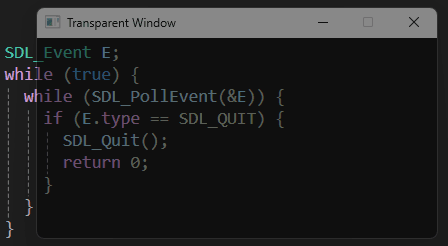Window Opacity
Discover how to use SDL3 functions for controlling and retrieving window transparency settings.
On some platforms, we can set the opacity of our window. In this lesson, we explore how to adjust the transparency of SDL3 windows using SDL_SetWindowOpacity() and SDL_GetWindowOpacity(). We'll cover how to handle errors, retrieve the current opacity, and understand the practical uses of window transparency.
Opacity is represented by a floating-point number ranging from 0.0 to 1.0. The default value is 1.0, which represents a completely opaque window. A window with an opacity of 0.0 is fully transparent.
Intermediate values between 0.0 and 1.0 are used to make our windows semi-transparent. The following window has an opacity of 0.5:

Setting Opacity Using SDL_SetWindowOpacity()
To change a window's opacity, we use the SDL_SetWindowOpacity() function. This function takes two arguments: a pointer to the SDL_Window whose opacity we want to change and a float value representing the desired opacity.
The value should be between 0.0 (fully transparent) and 1.0 (fully opaque):
SDL_Window* Window{SDL_CreateWindow(
"Window", 400, 200, 0)};
SDL_SetWindowOpacity(Window, 0.5f);Error Handling When Setting Opacity
In SDL3, SDL_SetWindowOpacity() returns a bool indicating success or failure. This aligns with the updated error-handling pattern across the library. The function will fail if the provided SDL_Window* is invalid or if the platform doesn't support window opacity.
As usual, we can call SDL_GetError() to retrieve an explanation for the failure, a technique we covered in our lesson on .
if (!SDL_SetWindowOpacity(nullptr, 0.5f)) {
std::cout << "Error Setting Opacity: "
<< SDL_GetError();
}Error Setting Opacity: Invalid windowRetrieving Opacity Using SDL_GetWindowOpacity()
In SDL3, SDL_GetWindowOpacity() has been simplified to directly return the window's current opacity as a float. This is a change from SDL2, which used an output parameter.
SDL_Window* Window{SDL_CreateWindow(
"Window", 400, 200, 0)};
float Opacity = SDL_GetWindowOpacity(Window);
std::cout << "Window Opacity: " << Opacity;
SDL_SetWindowOpacity(Window, 0.5f);
Opacity = SDL_GetWindowOpacity(Window);
std::cout << "\nWindow Opacity: " << Opacity;Window Opacity: 1
Window Opacity: 0.5Error Handling When Retrieving Opacity
If SDL_GetWindowOpacity() fails (for example, if an invalid window pointer is passed), it will return -1.0f. We can check for this value to detect errors.
float Opacity = SDL_GetWindowOpacity(nullptr);
if (Opacity < 0.0f) {
std::cout << "Error Getting Opacity: "
<< SDL_GetError();
}Error Getting Opacity: Invalid windowIf the platform does not support opacity, SDL_GetWindowOpacity() will not report an error. Instead, it will simply return 1.0f, indicating the window is fully opaque.
Summary
In this lesson, we introduced how to manage window opacity in SDL3. We covered how to use SDL_SetWindowOpacity() and SDL_GetWindowOpacity() to set and retrieve transparency values, along with handling errors. Key takeaways:
- Use
SDL_SetWindowOpacity()to adjust a window's transparency. - Retrieve a window's current opacity with
SDL_GetWindowOpacity(). - Consider platform-specific limitations by implementing error handling and using
SDL_GetError()to debug issues.
Window Visibility
Learn how to control the visibility of SDL3 windows, including showing, hiding, minimizing, and more